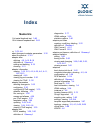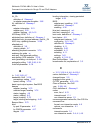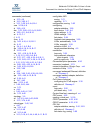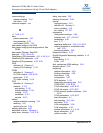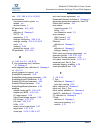
SANsurfer FC/CNA HBA CLI User’s Guide
Command Line Interface for QLogic FC and FCoE Adapters
Glossary-8 SN0054614-00 K
port instance
The number of the port in the system.
Each adapter may have one or multiple
ports, identified with regard to the adapter
as port 0, port 1 and so forth. to avoid
confusion when dealing with a system
containing numerous ports, each port is
assigned a port instance number when the
system boots up. So Port 0 on an adapter
might have a port instance number of, for
example, 8 if it is the eighth port discov-
ered by the system.
QoS
Quality of service refers to the methods
used to prevent bottlenecks and ensure
business continuity when transmitting data
over virtual ports by setting priorities and
allocating bandwidth.
quality of service
See QoS.
SAN
Storage area network. Multiple storage
units (disk drives) and servers connected
by networking topology.
SCSI
Small computer system interface. A
high-speed interface used to connect
devices, such as hard drives, CD drives,
printers, and scanners, to a computer. The
SCSI can connect many devices using a
single controller. Each device is accessed
by an individual identification number on
the SCSI controller bus.
SerDes
A Serializer/Deserializer (SerDes
pronounced sir-dees) is a pair of functional
blocks commonly used in high speed
communications. These blocks convert
data between serial data and parallel inter-
faces in each direction.
small computer system interface
See SCSI.
SFP
Small form factor pluggable is a
1-/2-/4-/8-Gbps transceiver device
(smaller than a Gigabit interface converter)
that plugs into the Fibre Channel port.
storage area network
See SAN.
sysfs
A virtual file system provided by the 2.6
Linux kernel. Sysfs exports information
about devices and drivers from the kernel
device model to userspace, and is also
used for configuration.
target
The storage-device endpoint of a SCSI
session. Initiators request data from
targets (typically disk-drives, tape-drives,
or other media devices). Typically a SCSI
peripheral device is the target but an
adapter may, in some cases, be a target. A
target can contain many LUNs.
A target is a device that responds to a
requested by an initiator (the host system).
Peripherals are targets, but for some
commands (for example, a SCSI COPY
command), the peripheral may act as an
initiator.
target binding
The process in which the adapter driver
binds a target ID using a target’s world
wide port name (WWPN) or port ID. This
enables the target ID to always connect to
the WWPN or port ID across reboots
regardless of SAN reconfigurations.














